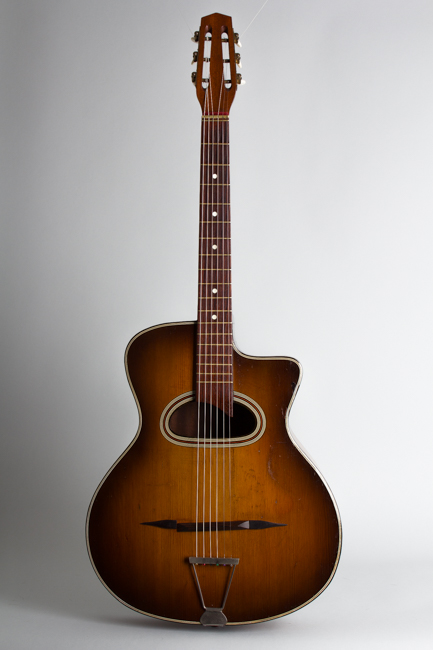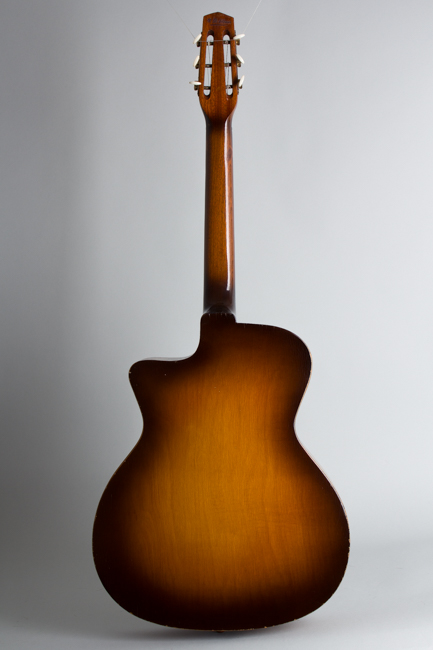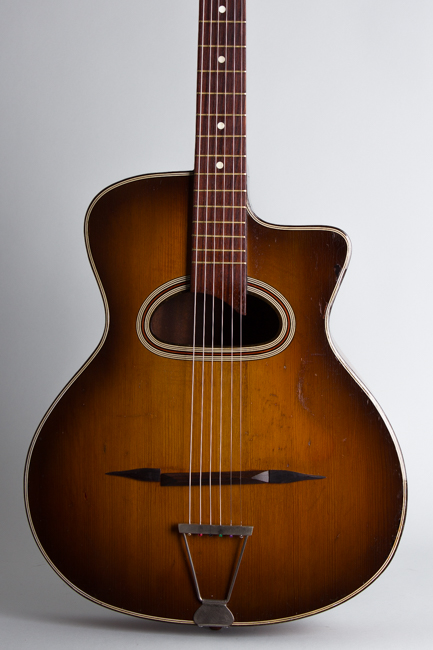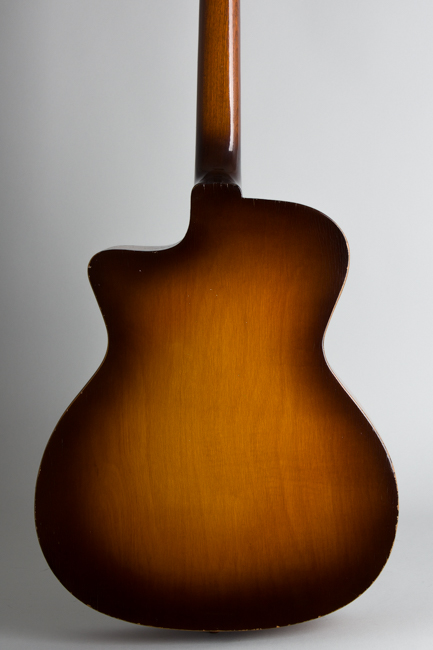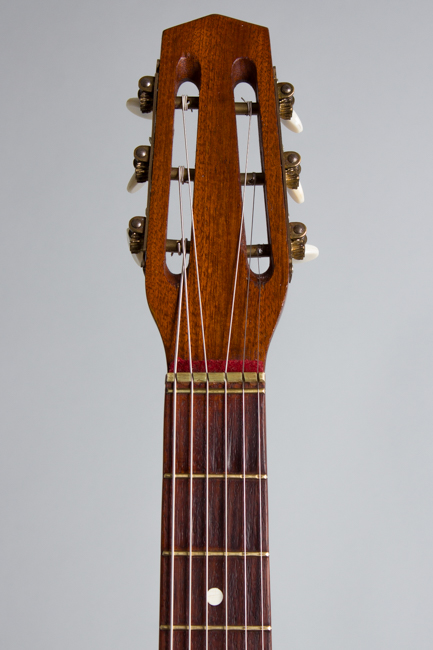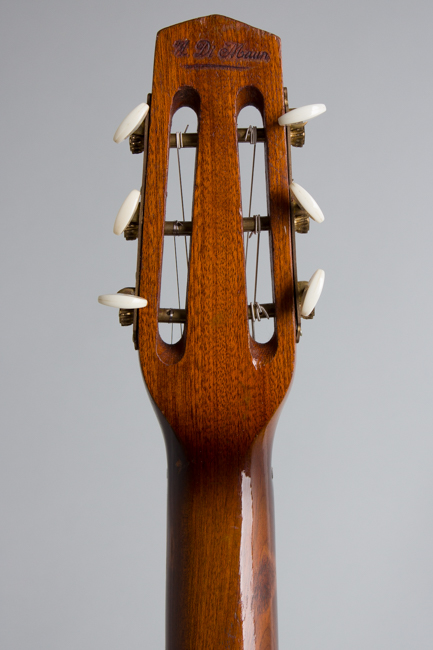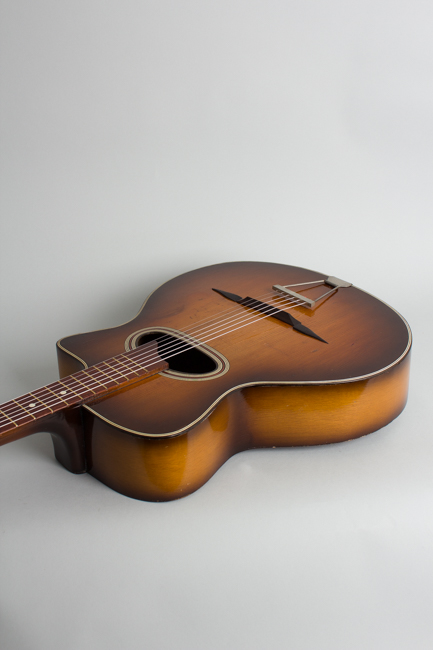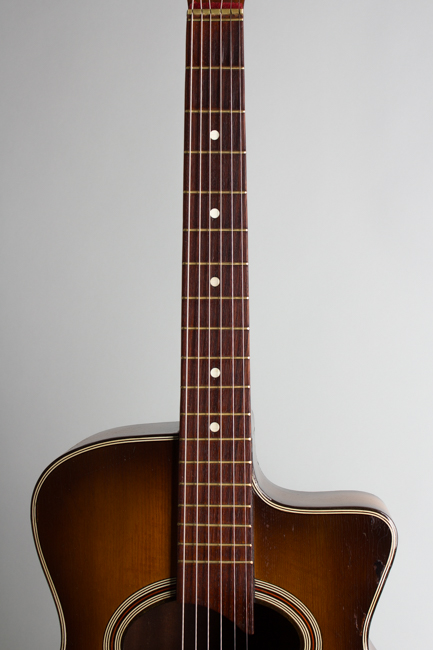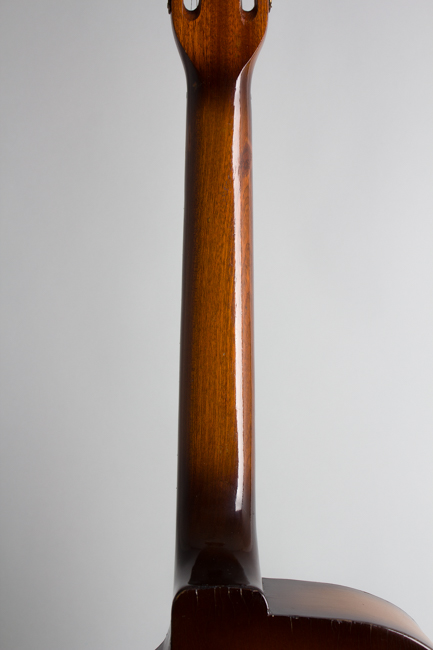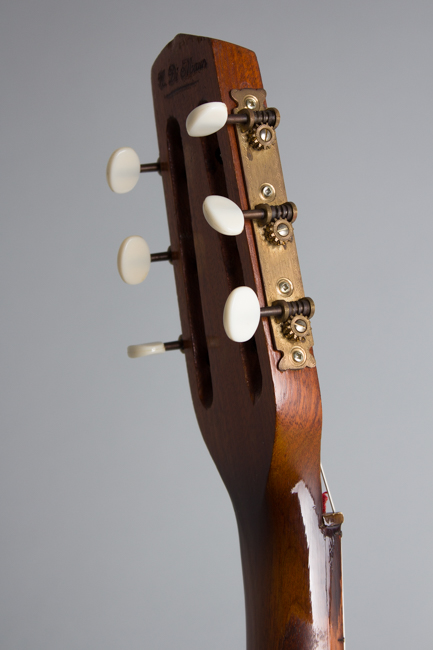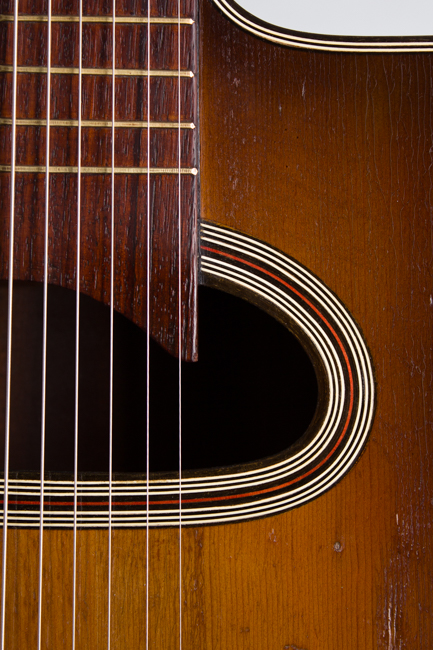A. DiMauro Boogie Woogie Gypsy Jazz Guitar (1950s)
Item # 12072
Prices subject to change without notice.
A. DiMauro Boogie Woogie Model Gypsy Jazz Guitar (1950s), made in Paris, France, sunburst lacquer finish, black gig bag case.
Antoine Di Mauro was one of a number of Sicilian luthiers who left Catania to set up shop on the East side of Paris in the early 20th century. By the 1930s several of these artisans began making guitars in the Selmer Maccaferri style, which became the defacto standard for followers of Django and French jazz/pop players in general. Di Mauro was one of the most consistently successful and of these Franco-Sicilian luthiers and his instruments became popular with players in many styles.
The colorfully named "Boogie Woogie" model was Di Mauro's most specifically Maccaferri inspired instrument. It is a simplified version of the original "Grand Bouche" Modele Orchestre, less sophisticated but in some ways more solidly built. This guitar features a 12 fret neck joint on a 16" wide body, slightly larger than the original Selmer. The top is spruce, the arched back is laminated while the sides appear solid. The top is bordered in wide 5-ply purfling. The festive rosette features 14 large black and white bands with a red center. The neck appears to be mahogany with a deep "D" profile, the dot-inlaid fingerboard is rosewood with original brass frets. The tuners, tailpiece and Maccaferri-style bridge with separate ends are typical for this style of instrument.
The "Boogie Woogie" model has long been considered one of the best "pompe" (rhythm) guitars ever made for Gypsy jazz. The Di Mauro family were deeply in touch with the needs of professional Gypsy guitarists, allowing them to produce instruments which were perfectly suited for the aesthetics of this genre. The sound is richer than some Gypsy-styled guitars without losing the all-important projection. It can produce focused, full bodied chords and the singing melodies typical of the European jazz tradition, and can stand more "forcing" than some more delicate guitars of this type. It is currently strung with the specific silk-cored strings specifically preferred by players in this style but is sturdier than a vintage Selmer and could also handle standard acoustic strings if desired. While not artistic match for a genuine Selmer, this is a splendid authentic Parisian instrument with its own delightful character.
Overall length is 39 1/2 in. (100.3 cm.), 16 in. (40.6 cm.) wide at lower bout, and 4 in. (10.2 cm.) in depth at side, taken at the end block. Scale length is 25 in. (635 mm.). Width of nut is 1 11/16 in. (43 mm.).
This guitar has some signs of use but remains in very fine playing condition for its age. The top finish shows checking and some dings, dents and scrapes along with a few small screwholes from a long-ago removed pickguard. There are a few small finish touch-ups to the top, visible but not too intrusive. The back and sides have some typical fairly light wear, mostly to the unbound back edges. The back of the neck has some wear to the wood behind the first fret. The instrument is structurally sound with no visible cracks or repairs except a visible deep scratch/indent into the side at the turn of the lower treble bout. It appears all original and plays quite well with a lovely yet punchy sound, instantly redolent of a quick trip to la belle Paris for the soul, anyway. Overall Excellent - Condition.
Antoine Di Mauro was one of a number of Sicilian luthiers who left Catania to set up shop on the East side of Paris in the early 20th century. By the 1930s several of these artisans began making guitars in the Selmer Maccaferri style, which became the defacto standard for followers of Django and French jazz/pop players in general. Di Mauro was one of the most consistently successful and of these Franco-Sicilian luthiers and his instruments became popular with players in many styles.
The colorfully named "Boogie Woogie" model was Di Mauro's most specifically Maccaferri inspired instrument. It is a simplified version of the original "Grand Bouche" Modele Orchestre, less sophisticated but in some ways more solidly built. This guitar features a 12 fret neck joint on a 16" wide body, slightly larger than the original Selmer. The top is spruce, the arched back is laminated while the sides appear solid. The top is bordered in wide 5-ply purfling. The festive rosette features 14 large black and white bands with a red center. The neck appears to be mahogany with a deep "D" profile, the dot-inlaid fingerboard is rosewood with original brass frets. The tuners, tailpiece and Maccaferri-style bridge with separate ends are typical for this style of instrument.
The "Boogie Woogie" model has long been considered one of the best "pompe" (rhythm) guitars ever made for Gypsy jazz. The Di Mauro family were deeply in touch with the needs of professional Gypsy guitarists, allowing them to produce instruments which were perfectly suited for the aesthetics of this genre. The sound is richer than some Gypsy-styled guitars without losing the all-important projection. It can produce focused, full bodied chords and the singing melodies typical of the European jazz tradition, and can stand more "forcing" than some more delicate guitars of this type. It is currently strung with the specific silk-cored strings specifically preferred by players in this style but is sturdier than a vintage Selmer and could also handle standard acoustic strings if desired. While not artistic match for a genuine Selmer, this is a splendid authentic Parisian instrument with its own delightful character.
Overall length is 39 1/2 in. (100.3 cm.), 16 in. (40.6 cm.) wide at lower bout, and 4 in. (10.2 cm.) in depth at side, taken at the end block. Scale length is 25 in. (635 mm.). Width of nut is 1 11/16 in. (43 mm.).
This guitar has some signs of use but remains in very fine playing condition for its age. The top finish shows checking and some dings, dents and scrapes along with a few small screwholes from a long-ago removed pickguard. There are a few small finish touch-ups to the top, visible but not too intrusive. The back and sides have some typical fairly light wear, mostly to the unbound back edges. The back of the neck has some wear to the wood behind the first fret. The instrument is structurally sound with no visible cracks or repairs except a visible deep scratch/indent into the side at the turn of the lower treble bout. It appears all original and plays quite well with a lovely yet punchy sound, instantly redolent of a quick trip to la belle Paris for the soul, anyway. Overall Excellent - Condition.
